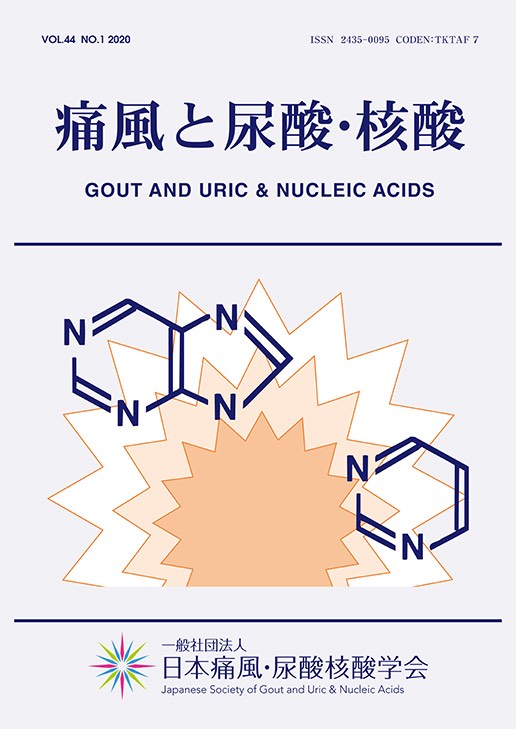Volume 44, Issue 1
Gout and Uric & Nucleic Acids
Displaying 1-17 of 17 articles from this issue
- |<
- <
- 1
- >
- >|
Information
-
2020 Volume 44 Issue 1 Pages info_1_1-
Published: July 25, 2020
Released on J-STAGE: July 25, 2020
Download PDF (199K) -
2020 Volume 44 Issue 1 Pages info_1_2-
Published: July 25, 2020
Released on J-STAGE: July 25, 2020
Download PDF (203K) -
2020 Volume 44 Issue 1 Pages info_1_3-info_1_4
Published: July 25, 2020
Released on J-STAGE: July 25, 2020
Download PDF (116K) -
2020 Volume 44 Issue 1 Pages info_1_5-
Published: July 25, 2020
Released on J-STAGE: July 25, 2020
Download PDF (224K)
Review 1
-
2020 Volume 44 Issue 1 Pages 1-6
Published: July 25, 2020
Released on J-STAGE: July 25, 2020
Download PDF (957K)
Review 2
-
2020 Volume 44 Issue 1 Pages 7-14
Published: July 25, 2020
Released on J-STAGE: July 25, 2020
Download PDF (849K)
Original Article 1
-
2020 Volume 44 Issue 1 Pages 15-22
Published: July 25, 2020
Released on J-STAGE: July 25, 2020
Download PDF (771K)
Original Article 2
-
2020 Volume 44 Issue 1 Pages 23-31
Published: July 25, 2020
Released on J-STAGE: July 25, 2020
Download PDF (1078K)
Original Article 3
-
2020 Volume 44 Issue 1 Pages 33-39
Published: July 25, 2020
Released on J-STAGE: July 25, 2020
Download PDF (416K)
Original Article 4
-
2020 Volume 44 Issue 1 Pages 41-48
Published: July 25, 2020
Released on J-STAGE: July 25, 2020
Download PDF (450K)
Original Article 5
-
2020 Volume 44 Issue 1 Pages 49-53
Published: July 25, 2020
Released on J-STAGE: July 25, 2020
Download PDF (1069K)
Original Article 6
-
2020 Volume 44 Issue 1 Pages 55-60
Published: July 25, 2020
Released on J-STAGE: July 25, 2020
Download PDF (613K)
Original Article 7
-
2020 Volume 44 Issue 1 Pages 61-74
Published: July 25, 2020
Released on J-STAGE: July 25, 2020
Download PDF (510K)
Original Article 8
-
2020 Volume 44 Issue 1 Pages 75-81
Published: July 25, 2020
Released on J-STAGE: July 25, 2020
Download PDF (346K)
53th Japanese Society of Gout and Uric & Nucleic Acids Meeting records
-
2020 Volume 44 Issue 1 Pages 83-84
Published: July 25, 2020
Released on J-STAGE: July 25, 2020
Download PDF (181K)
General subject
-
2020 Volume 44 Issue 1 Pages info_1_6-info_1_8
Published: July 25, 2020
Released on J-STAGE: July 25, 2020
Download PDF (254K) -
2020 Volume 44 Issue 1 Pages 85-152
Published: July 25, 2020
Released on J-STAGE: July 25, 2020
Download PDF (1422K)
- |<
- <
- 1
- >
- >|
